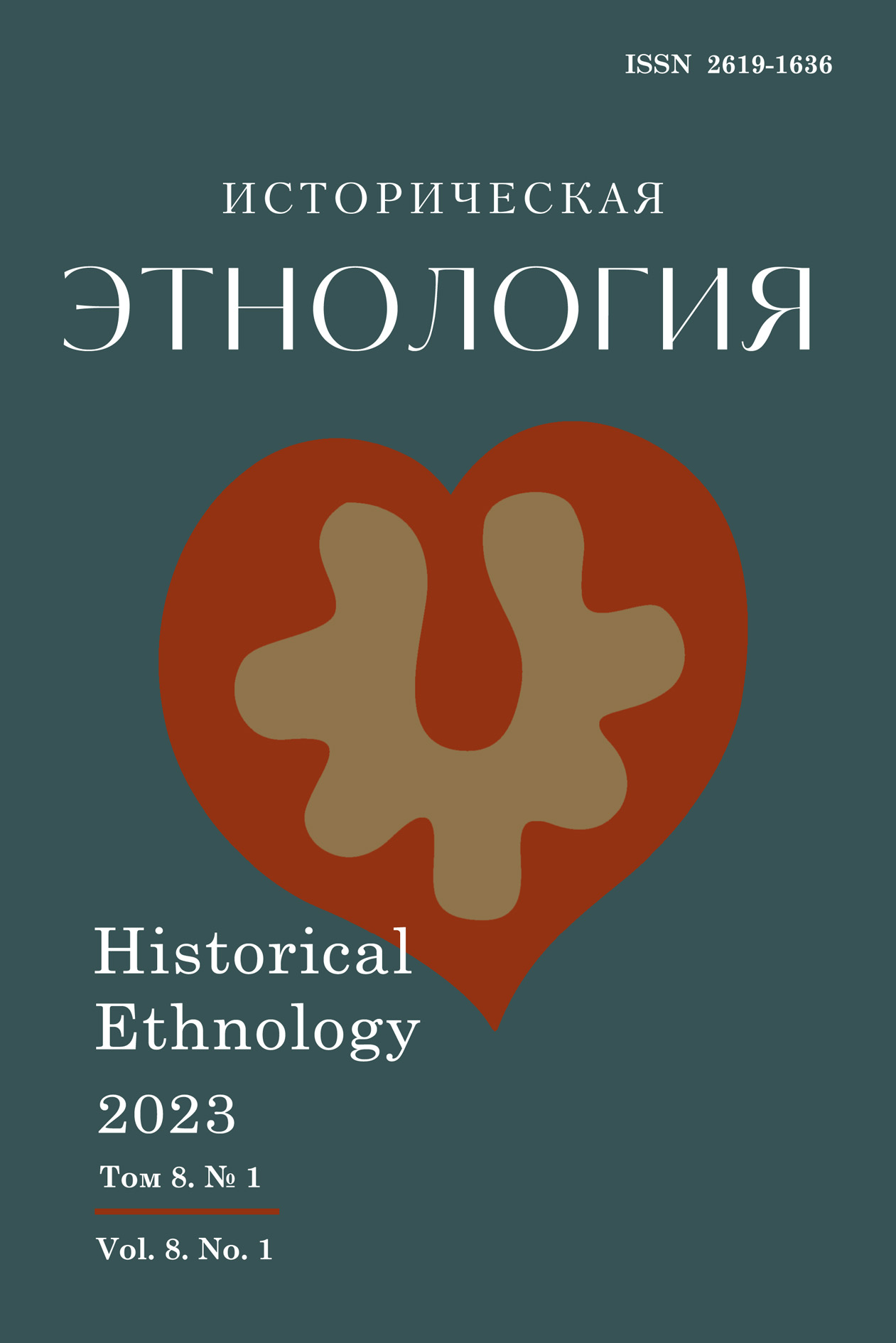Tatar clasp-necklace yaka chylbyry: questions of genesis and ethno-cultural interrelations
Suslova S.V., Donina L.N.
94-111 p.
doi.org: 10.22378/he.2023-8-1.94-111
The article is devoted to the history of the formation of the ethnospecific jewelry of the Kazan Tatars – a collar clasp-necklace called yaka chylbyry. This piece of jewelry in its classic look had formed by the early-middle 19th century. However, the artistic image of the constituent elements of this multicomponent product, as well as the techniques of its manufacture, go back to medieval traditions. The publication focuses on an earlier constructive analogue of the yaka chylbyry – a clasp for a woman's camisole in the shape of double sheep larvae. The functional reorientation – the use of a clasp for a doublet as a collar clasp-necklace occurred at the turn of the 18th–19th centuries. The ram's face is considered by the authors as a result of the historical transformation of the "scarab" image typical for Russian caftan fasteners of the 16th–19th centuries. Echoes of the stylized motif of the ram can be seen on the classic yaka chylbyry up to the early-middle of the 20th century.
Keywords: Tatars, traditions, jewelry, casting, cultural genesis
For citation: Suslova S.V., Donina L.N. (2023) Tatar clasp-necklace yaka chylbyry: questions of genesis and ethno-cultural interrelations. Istoricheskaya etnologiya [Historical Ethnology]. Vol. 8. No. 1: 94–111. DOI: 10.22378/he.2023-8-1.94-111 (In Russ.)
REFERENCES
Avizhanskaya S.A., Bikbulatov N.V. Kuzeev R.G. (1964) Decorative and applied arts of the Bashkirs. Ufa. (In Russ.)
Bulatova A.G., Gadzhieva S.Sh., Sergeeva G.A. (2001) Clothing of the peoples of Dagestan. Historical and ethnographic atlas. Pushchino: ONTI PNC RAN Publ. (In Russ.)
Etnografiya na B”lgariya. (1983). Vol. 2. Materialna kultura. Sofiya: 113–117. (In Bulg.)
Fuks K.F. (1844) Kazan Tatars in statistical and ethnographic terms. Kazan. (In Russ.)
Gagen-Torn N.I. (1960) Women’s clothing of the peoples of the Volga Region: materials for ethnogenesis. Cheboksary: Chuvash state Publ. (In Russ.)
Khovanskaya O.S. (1958) Breast decoration from the Bulgar city of Dzhuketau. Sovetskaya Аrkheologiya [Soviet Archeology]. No. 1: 239–243. (In Russ.)
Jewelry of the Turkic peoples of Eurasia. Historical and ethnographic essays. (2018) Suslova S.V., Gabdrakhmanova G.F., Pavlinskaia L.R. (eds). Kazan: Sh. Marjani Institute of History of the Republic of Tatarstan Academy of Sciences. (In Russ.)
Kalinin N.F. (1948) Revisiting the question of the origin of the Kazan Tatars. In: Origin of Kazan Tatars. Kazan: Tatgosizdat Publ.: 96–108. (In Russ.)
Khaany Ezent güren MONGOL (2018). Solongosyn Үndesniy muzey. (In Mong.)
Merchant portrait of the 18th – early 20th centuries from the collection of the Historical Museum. Painting. Daguerreotype. Photo (2013). No. 37. Moscow. (In Russ.)
Minasyan R.S. (2014) Metalworking in antiquity and the Middle Ages. St. Peterburg: State Hermitage Publ. (In Russ.)
Putnev P. (1981) Bulgarian folk clothes. Sofiya: DI Sentemvri Publ. (In Russ.)
Suraganov S.K. (2014) Revisiting the question of the popularity of the traditional horn-shaped ornamental motif in the art of Eurasian peoples. In: In the world of science and arts: Issues of philology, art criticism and cultural studies. Vol. 2 (33). No II. Novosibirsk: 74–80. (In Russ.)
Suslova S.V. (2020) Materials for the cultural genesis of the Volga-Ural Tatars: the Nogai component in the structure of the folk costume. Istoricheskaya etnologiya [Historical Ethnology]. Vol. 5, no. 1: 6–26. DOI: 10.22378/he.2020-5-1.6-26 (In Russ.)
Suslova S.V., Mukhamedova R.G. (2000) Folk costume of the Tatars of the Volga Region and the Urals: middle 19th – early 20th centuries. Historical and ethnographic atlas of the Tatar people. Kazan: Fӓn Publ. (In Russ.)
Tallgren A.M. (1918) Collection Zaussäilov au Musee National de Finland a Helsingfors II. Vol. 1–2. Helsingfors. (In Finn.)
Vaynshtein S.I. (1974) History of folk art of Tuva. Moscow: Nauka Publ. (In Russ.)
Valeev F.H. (1969) Ornament of the Kazan Tatars. Kazan: Tatar Book Publ. (In Russ.)
Valeeva D.K. (1983) Arts of the Volga Bulgars 10th – early 13th centuries. Kazan: Tatar Book Publ. (In Russ.)
Vecheslav N.N. (1878) Description of the costumes of Russians and foreigners among the peasants of the Kazan Province. Kazan: Provincial Printing Publ. (In Russ.)
Vol’naya G.N., Nayfonova F.T. (2016) The Image of a Sheep in the Applied Arts of the Koban Culture and the Traditional Culture of the Population of the Central Caucasus. Izvestiya Severo-Osetinskogo instituta gumanitarnykh i sotsial’nykh issledovaniy im. V.I. Abaeva [Proceedings of the North Ossetian Institute for Humanitarian and Social Research named after V.I. Abaev]. No. 21 (60): 5–23. (In Russ.)
Vorob’ev N.I. (1953) Kazan Tatars. Kazan: Tatar state Publ. (In Russ.)
Zhilina N.V. (2015) Clasps in the costume of Muscovite Rus’: a preliminary essay. In: Archeology of the Moscow Region. Vol. 11. Moscow: IA RAN Publ.: 227–253. (In Russ.)
About the authors: Svetlana V. Suslova, Cand. Sc. (History), Leading Research Fellow of the Department of Ethnological Research, Marjani Institute of History of the Tatarstan Academy of Sciences (7А, Baturin St., Kazan 420111, Russian Federation), sv_suslova@mail.ru
Larisa N. Donina, Cand. Sc. (Art History), Senior Research Fellow of the Department of Ethnological Research, Marjani Institute of History of the Tatarstan Academy of Sciences (7А, Baturin St., Kazan 420111, Russian Federation); lis.art@mail.ru
Received January 13, 2023 Accepted for publication March 26, 2023
Published Online October 23, 2023
|
|








